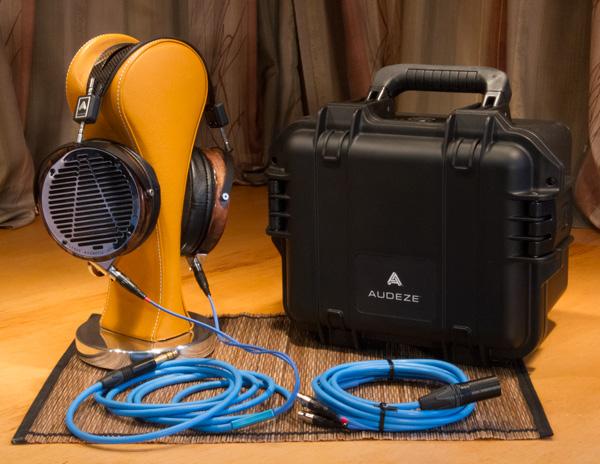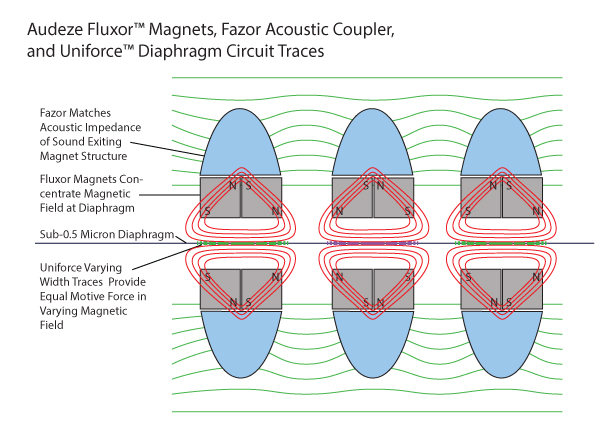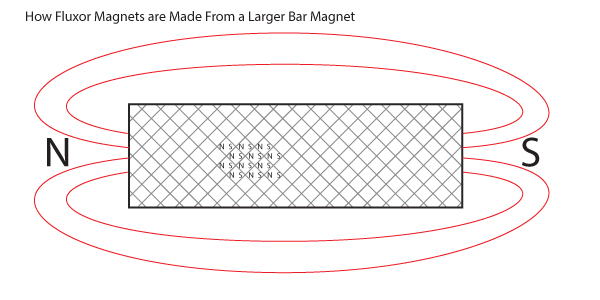| Columns Retired Columns & Blogs |
The Technologically Impressive LCD-4 Planar Magnetic Headphone

This story originally appeared at InnerFidelity.com
[Editor's Note: Through a long and tedious process it was found that the Focal Utopia and Audeze LCD-4 reviewed here at InnerFidelity in numerous articles were found to be not representative of currently manufactured product. This article is therefore not entirely indicative of our current impressions of this product. To get a complete understanding of our evaluation the reader should start with this summary article and work back through the articles leading up to our current understanding.]
For me, the story of the Audeze LCD-4 ($3995) is primarily a story about invention, research, and corporate learning. Audeze's latest flagship, to my eyes, is less a simple product, and more an artifact evidencing the progress of a long and involved technical battle to take the previously underdeveloped planar magnetic headphone technology beyond the capabilities of tradition dynamic drivers. Make no mistake about it, Audeze is on that trajectory, and the LCD-4 provides an opportunity to take a close look at the work accomplished.
Briefly, the LCD-4 is a full-size, around-the-ear, open acoustic headphone and remains superficially much like its LCD-3 predecessor; differentiated by chromed grills, a 3-meter hefty blue cable, and sporting a very nice carbon fiber headband with a wide, floating, glove leather headband strap. Though a large and heavy headphone, I find its very ample and plush ear cushions and wide headband cozy and comfortable. You don't so much put these on your head as you do put your head inside the headphones. A sonic helmet of sorts.
Those that live in hot, humid climes may well be served by a cooler headphone; and folks with slight frames may find them too heavy. But for those intent to hear the drive and authority that planar magnetic headphones provide, I think the weight and warmth will amount to a minor inconvenience.
Also included is a hard-side, Pelican-case-like storage and carry case with locking closures. A perfect accessory to carry your cans to the next headphone meet.
Audeze and Technological Advancement
I'm very fortunate to have known Sankar Thiagasamudram, CEO of Audeze, since the very earliest days of Audeze's inception when they first showed a off-the-shelf headphone modified with their first prototype planar magnetic driver. Since that time, we've continued to meet at shows and talk about new products, of course, but more importantly for me, we've also spent a good deal of time talking about the technical adventure of advancing the state-of-the-art in planar magnetic headphone drivers.
In fact, a few years ago I arranged a visit to their headquarters to get a half day's lesson on how planar magnetic headphones work from Dr. C., Audeze's CTO. The resulting article can be found here.) This training in order to be complete included both on and off the record information, as has had many discussions subsequently. I mention this for two reasons: First, as a matter of disclosure; I do have a fairly regular relationship with the engineering team at Audeze; and am privy to a small but meaningful amount of propriety information. Personally, I don't have an ethical problem as dialog is always focussed on learning about this developing technology in an effort to understand it and be able able to explain it to InnerFidelity readers. I also don't think it effects or biases my judgements—I'll offer the fact that I recently removed the LCD-2 and LCD-3 from the "Wall of Fame" and wrote about past unit-to-unit driver variations.
The second and more important reason I bring up Audeze's technological prowess is because it's damned impressive. I've been to the labs at Sennheiser, AKG, and Beyerdynamic; and I used to visit all manner of super-high-tech labs as a scanning electron microscope technician. While Audeze's lab is of small size in comparison, it remains an awesome experience to go into a room with a couple million dollars worth of gear and more than one doctor in some exotic specialty with their faces pressed up against computer screens flickering with color as they closely study finite element animations. This is clearly a place where the boundary of the unknown is slowly but surely being brought into view, and earshot, for us all.
LCD-4 Technological Detail
While the LCD-4 looks quite similar to the LCD-3 from the outside, they are quite different on the inside. Differences include:
- Sub 0.5 micron diaphragm.
- Uniforce diaphragm circuit.
- Fluxor magnet arrays on both sides of the diaphragm.
- Fazor acoustic impedance matching elements on outer and inner side of magnet arrays.
- Aperiodic ear-pad vent.

Most of the dialog on this page refers to this diagram, which is for illustrative purposes only and is not at all to scale.
Diaphragm - Audeze characterizes their LCD-4 diaphragm as "nano-grade". The actual dimension is proprietary, but Sankar told me it was sub-0.5 microns thick. For scale, a human hair is about 100 microns in diameter on average—200 times thicker than the LCD-4 diaphragm.
Diaphragm construction is a fairly lengthy and largely propriety process. Basically, the material is drawn through a device that slowly deposits a very thin layer of Aluminum on the surface, and then spooled onto another roll. When the entire roll is on the take-up spool it switches directions and the process is repeated. Audeze claims this very gradual rate of deposition ensures the aluminum layer has an extremely fine grain structure. Stress factors under mechanical load will often cause failures the originate at grain boundaries, and therefore, smaller grain structure is preferable. From Wiki here:
Fatigue occurs when a material is subjected to repeated loading and unloading. If the loads are above a certain threshold, microscopic cracks will begin to form at the stress concentrators such as the surface, persistent slip bands (PSBs), and grain interfaces.[1] Eventually a crack will reach a critical size, the crack will propagate suddenly, and the structure will fracture.
Audeze believes making the aluminum with a very fine grain structure will reduce failure. Additionally, thinner traces will reduce stress in the bulk of the material. When the LCD-4 was first introduced it had a short run of headphones with a 100 Ohm impedance. This was quickly changed to 200 Ohms by halving the thickness of the deposited aluminum layer. I assume this was done to reduce the possibility of stress fractures, and therefore failure by open circuit of the diaphragm circuit traces. Audeze will replace the drivers of anyone who purchased the 100 Ohm version of the LCD-4 with the newer 200 Ohm version if they so choose.
Once aluminum deposition is complete, the diaphragm undergoes another proprietary process to remove the unwanted aluminum, leaving the only the finished diaphragm circuit traces.
Uniforce Diaphragm Circuit - Although the Fluxor magnet array does a very good job of producing a magnetic field with evenly distributed strength (isodynamic field), there remain small differences in magnetic field strength over the surface of the diaphragm. If all the circuit traces were of the same size and evenly distributed over the diaphragm surface, the varying magnetic field would cause the motive force of the circuit traces to fluctuate from position to position across the diaphragm surface. This unevenness of force acting on the diaphragm surface may instantiate modal break-up (Eigenmodes).
Audeze's Uniforce circuit combats this possibility by unequally distributing the position and width of traces such that they provide equal motive force within the varying magnetic field. They claim it delivers more even and predictable diaphragm movement.
Fluxor Magnets - I very clearly remember my palm meeting my face when I first heard about this design; "D'oh! Why didn't I think of that!" The Fluxor magnets are essentially a pair of magnets polarized from corner to corner and brought together to cause the main poles of the magnet to sit at the outside corners nearest the diaphragm. This concentrates the bulk of magnetic field at the diaphragm.

My initial wonder of how something might be magnetically polarized corner-to-corner was punctuated by yet another self-induced slap to the forehead when I learned a large neodymium bar magnet is simply sliced and diced on a forty five degree angles.
This configuration produces 1.5 Tesla of magnetic field strength at the diaphragm, which Audeze claims is the highest field strength in any headphone made today. I find it beautiful in its simplicity.
Fazor Acoustic Impedance Matching Element - Fazor elements are positioned on both the inside and outside of the driver where sound exits from between the magnets. These elements are designed to provide a smooth transition for sound as it passes from the diaphragm, through the magnets, and toward the ear (or the outside of the headphones).
There is an opinion floating around the enthusiast community that the Fazors did something negative to the sound. It did appear to me that bass level did drop slightly around the time of the Fazor introduction, though I'm not sure this was the symptom noted by enthusiasts. I would urge caution in ascribing any changes in sound solely to the Fazor—Audeze (and most all manufacturers of complex gear) continually change product for performance improvement, but also for manufacturability and supplier parts availability. I suggest there may be other reasons for the perceived change at the time of the Fazor introduction. I've seen some pretty convincing evidence that the Fazors are a net positive in Audeze driver performance.
Aperiodic Ear Pad Damping Ring - Well...that's not what Audeze calls it. New to the LCD-4 has what looks like a felt ring between the base of the ear pads and the capsule housing of the headphone. Audeze claims the main purpose for this ring is to provide a slightly lossy ear chamber for the headphones. When you put headphones on, air trapped in the ear chamber of the headphone can exert significant pressure on the diaphragm. With some headphones (not just planar magnetics) if you push the headphone against the side of your head while being worn, you can hear a crinkling sound. This happens because air trapped between your head and the headphones increases pressure as you push in, and this pressure against the diaphragm can, at times, deform the diaphragm much more strongly than even a quite loud audio signal.
The diaphragm of the LCD-4 is very thin, and an over-pressure, which might happen as you don and doff the headphones, could deform and/or degrade diaphragm performance. To combat this, Audeze has added this felt ring to provide pressure relief for the diaphragm. But, to my eyes, it seems there may be other advantages.
In all measurements I've made of LCD-2/3/X headphones in the past, I see evidence of "pad bounce" somewhere between 30Hz and 80Hz. This appears as a gentle wiggle in frequency response, below which response begins to fall off. This "pad bounce" is essentially the resonant frequency of the elasticity of the ear pad and enclosed air. This phenomenon can also be seen with some headphones (not LCD as frequency may be too low to observe) in the isolation curve as outside sound stimulates the resonance and actually provides a modest gain, rather than loss, of outside sound heard. Measurements of the LCD-4 show no evidence at all of pad bounce!
Though there may be other reasons—like changes in pad foam or cover material—it seems to me quite logical that this felt damping ring may spoil the Q of the pad/enclosure system and reduce this very low frequency resonance.
A byproduct of this reduction in Q might be better bass extension. My measurements do quite clearly show excellent bass extension in the LCD-4. In an email correspondance, Dr. Drag Colich, CTO of Audeze (commonly known as "Doc C."), said it was not too much of a stretch to call this an "aperiodic vent", but that it's not working in quite the same way it does with speakers—where it is used to spoil the Q of a speaker enclosure. He did, however, say that the much improved bass extension was primarily due to the increased compliance of the very thin diaphragm, which lowers the primary driver resonance and allows for larger diaphragm excursion. He has driver measurements showing the 3dB down point in the bass at around 5Hz!
Okay, maybe it's not an aperiodic vent, but I like the idea and couldn't resist throwing it out to Audeze and hearing what they had to say. For more info on what the heck an aperiodic vent is, go here, here, or here.
Fine Tuning Process - All of the above information is rather course when compared to the actual work of tweaking and tuning headphone performance. Sankar told me their process is usually done in three stages: Optimizing magnetic structure to create the most uniform flux density possible; optimizing diaphragm circuit traces to produce the most evenly distributed motive force across the surface of the diaphragm; and lastly, optimizing the acoustics around the driver for best performance—which was usually expressed to me as best impulse response performance.
In confidence, Sankar showed me a few very interesting finite element modeling results investigating diaphragm Eigenmodes and how to reduce them. The results were pretty darn spectacular. He said they spent many, many, many hours making small tweaks to various geometries within the driver, each time iterating through the modeling. By the sound of it, no part was left un-tweaked in one way or another.
I did walk away with one important impression, however: The so-called "Ortho Wall" (thin, high-Q resonance ridges seen in cumulative spectral decay plots of most all planar magnetic headphones) is very likely due to diaphragm Eigenmodes. As much as we might like to think these diaphragms are moving like well behaved pistons, they're not.
Summarizing the Engineering Detail
I must say I deeply enjoyed the dialog with Audeze surrounding my LCD-4 review. It focussed more on principle than the particular product. I came away impressed yet again with Audeze's campaign to command a leading position in research and development in planar magnetic headphones.
The dialog had a secondary pay-off, this one accruing to InnerFidelity readers. My badgering for information over the last week has resulted in the completion of a tidy little white paper done by the driver design team at Audeze describing in some detail—graphs and colorful flux density simulation cross-sections included—the magnetic structure of the Fluxor in the LCD-4 compared with other designs. You can pick it up here.
And now, onto the important bit: How is the sound quality of the LCD-4?
- Log in or register to post comments




































